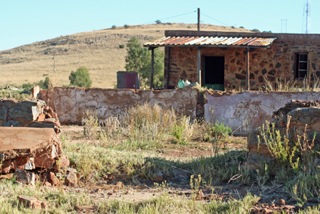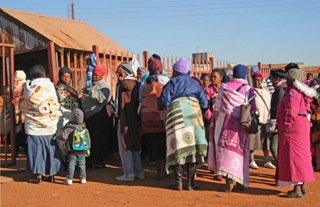"Awaking on Friday morning, June 20, 1913, the South African native found himself, not actually a slave, but a pariah in the land of his birth…"
- Sol Plaatjie (1916)
June , 2013, marks 100 years since the notorious Natives Land Act came into effect in South Africa, severely restricted land ownership and freedom of residence within South Africa. By giving the white minority control over most of the land in South Africa, this law effectively led to the displacement of the black majority, forcing them to reside in a mere 7.3% of the country designated to be ‘native reserves’.
 Since the beginning of 2013, SAHA has been working on an oral history and photographic project exploring the legacies of the 1913 Land Act in three communities - Driefontein, Mogopa and Braklaagte - all sites of subsequent collective struggle against attempts by the apartheid government to relocate these so-called ’black spots’ forcibly from land demarcated for white settlement.
Since the beginning of 2013, SAHA has been working on an oral history and photographic project exploring the legacies of the 1913 Land Act in three communities - Driefontein, Mogopa and Braklaagte - all sites of subsequent collective struggle against attempts by the apartheid government to relocate these so-called ’black spots’ forcibly from land demarcated for white settlement.
As has been the practice in past SAHA projects (such as the Tembisa and Zenzo Nkobi projects), SAHA has been using its existing archive generatively within this project as a catalyst for the collection and creation of new archive. Historic images of these communities are present in SAHA's existing archives in the Gille de Vlieg collection (AL3274), reflecting her work in the 1980s as a fieldworker with the Transvaal Rural Action Committee (TRAC) of the Black Sash, a social justice organisation that was active in support of these struggles around land issues during apartheid.
 These photographs from the archives have been distributed in each community as postcards to raise awareness of the project and to prompt discussion about the people, places and events depicted within both individual and group interviews during site visits to conduct interviews in May and June 2013. To date, 16 interviews have been conducted with 17 individuals within these communities, amounting to nearly 20 hours of testimony. Gille de Vlieg is participating in this project through photographing the oral history collection process within Driefontein, Mogopa and Braklaagte in order to create a body of contemporary images that tell a story of life in each community today.
These photographs from the archives have been distributed in each community as postcards to raise awareness of the project and to prompt discussion about the people, places and events depicted within both individual and group interviews during site visits to conduct interviews in May and June 2013. To date, 16 interviews have been conducted with 17 individuals within these communities, amounting to nearly 20 hours of testimony. Gille de Vlieg is participating in this project through photographing the oral history collection process within Driefontein, Mogopa and Braklaagte in order to create a body of contemporary images that tell a story of life in each community today.
The project team will also be collecting digital copies of personal documents and photographs from members of each community on site as part of the interview process. These will be then brought together with records from the archives as well as the testimony collected in order to produce a report considering the legacy of the 1913 Land Act in South Africa today through a comparison of these community case studies.

Similar to other collective history projects conducted by SAHA (such as the 2011 - 2012 project on the Anti-Privatisation Project), a virtual exhibition will be created, which will include copies of all testimonies and archival materials gathered in the course of the project.
This will be made accessible both online through the SAHA domain and offline as a CD accompanying the report. Portable exhibitions of the project, along with copies of the print report will then be distributed within each community and deposited within local libraries and schools.
This project is funded by the Rosa Luxemburg Foundation.





 Since the beginning of 2013, SAHA has been working on an
Since the beginning of 2013, SAHA has been working on an  These photographs from the archives have been distributed in each community as postcards to raise awareness of the project and to prompt discussion about the people, places and events depicted within both individual and group interviews during site visits to conduct interviews in May and June 2013. To date, 16 interviews have been conducted with 17 individuals within these communities, amounting to nearly 20 hours of testimony. Gille de Vlieg is participating in this project through photographing the oral history collection process within Driefontein, Mogopa and Braklaagte in order to create a body of contemporary images that tell a story of life in each community today.
These photographs from the archives have been distributed in each community as postcards to raise awareness of the project and to prompt discussion about the people, places and events depicted within both individual and group interviews during site visits to conduct interviews in May and June 2013. To date, 16 interviews have been conducted with 17 individuals within these communities, amounting to nearly 20 hours of testimony. Gille de Vlieg is participating in this project through photographing the oral history collection process within Driefontein, Mogopa and Braklaagte in order to create a body of contemporary images that tell a story of life in each community today.